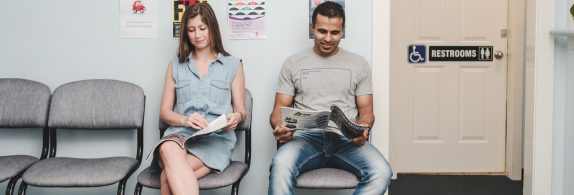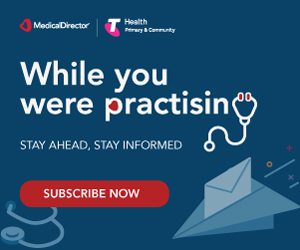Top patient engagement tips for 2019
Patient engagement can mean different things to both practitioner and patient, especially in the age of technology. So what will the future hold for patient engagement, when expectations and outcomes can be so easily impacted by digital innovation?
Embrace patient-centric design
In the age of proactive wellness and patient-centric care, we now have a deeper understanding of how a patient’s environment can contribute to healing and improved recovery time.
A recent report released by KPMG, Healthcare reimagined: Innovation trends, predictions and actions for healthcare leaders, revealed ‘proactive wellness’, which involves implementing solutions to help improve individuals’ health over time, needs to be supported by greater adoption of multidisciplinary design when designing healthcare facilities.
One of this report’s key recommendations is to implement human-centric change, which involves designing the practice with a focus on patient empathy.
“This can be achieved for instance, with simple considerations like widening the bathroom doors, or creating family and friend pods in the waiting room instead of rows of chairs,” GP and MedicalDirector’s Chief Clinical Advisor, Dr Charlotte Middleton, says. “All of these can make a big impact to both the patient’s first impressions of your practice and overall experience.”
“There are also some smart ways to can use technology to better engage with your patient,” she adds. “Try installing a TV screen up on the wall to perhaps show something you’re doing, discuss your patient’s results or share patient education resources.”
Offer more health information to patients
MedicalDirector’s recent Patient Engagement Survey 2018, has revealed patients expect a lot more information about their health than they are currently receiving from their GPs, and are resorting to searching online to find out more about their condition, both before and after their consultation.
The research shows most patients (78%) conducted online research to find out more about their condition or prescribed treatment, both before and after visiting their GP. But a majority 80% say they would have actually preferred that information come directly from the GP or Practice website, assuming it is of high quality.
“As the white paper alludes to, patients want doctors to be educating them more, that’s the bottom line,” Dr Charlotte Middleton, says. “And the survey reveals patients prefer doctors to be the source of that information, rather than Dr Google.”
“But the reality is, they are searching for that information online. As Doctors, we really don’t want our patients to be going to the Internet for answers, as a typical patient lacks the ability to interpret and contextualise the information. So the onus is on us, as doctors, to provide relevant and accurate information to patients.”
Dr Charlotte also stressed you might not have the time to explain the condition, but if you have a few resources on hand to share then it would make all the difference in helping the patient understand their condition better and how to manage it.
For instance, doctors can access and share HealthShare Fact Sheets, integrated in MedicalDirector’s software, to deepen patient understanding and drive better, more personalised clinical outcomes.
“You can quickly email them or print them – and it only take a few minutes,” she said. “What’s also powerful about a factsheet is a patient can then pass that information on to their family, which means their wider support group can also understand the patient’s condition and how to offer the right support. So in effect, that one point of communication from patient’s GP has a wider, more powerful reach that resonates with a broader community network.”
Transcend the four walls of the clinic
According to founder and CEO of patient engagement platform HotDoc, Dr Ben Hurst, patient engagement is a set of practice/patient interactions, which transcend the four walls of the consultation room and emphasise a proactive (rather than reactive) healthcare experience
“We perceive that every time a patient makes a booking, receives a reminder or checks in on our platform is an opportunity to make him/her healthier,” he says.
- Does the 25-year old student understand the importance of regular skin checks?
- Has the 50-year old diabetic heard about the Care Plan offered by the practice?
- Is the 75-year old pensioner aware he’s eligible for a free Herpes-Zoster vaccine?
“In the patient engagement model, the practice is the coach, the patient is the captain and their relationship is strong and enduring,” he adds. “It is now possible to impact health outcomes through more frequent and targeted interactions across the continuum of the patient experience.”
Healthcare gap participation and transparency
A greater level of transparency around health care gap transparency is set to allow healthcare providers to engage in more constructive conversations with their patients. In fact, a recent survey found that over 80% of GPs find gap participation data also helpful when making a patient referral decision2.
At the same time, informed discussions enable GPs and patients to create health care plans, which are consistent with their needs, values, and preferences. This level of positive engagement has been proven to influence the effectiveness of consultations, and result in better patient satisfaction and health outcomes.
Digital health company, HealthShare, believes that greater transparency empowers GPs and their patients to make better health decisions.
As a “patient first” neutral partner for all stakeholders: health practitioners, hospitals, private health insurers and others, HealthShare provides a balance of information. Direct participation rates from health insurers are displayed and Specialists also have the option of publishing their own ‘No Gap’ and ‘Known Gap’ participation rates.
Continuity of care and reducing no-shows
Patient no-shows can put a significant administrative, time and cashflow burden on any healthcare practice, and significantly affect a practice’s ability to offer patients the right continuity of care. Yet it’s becoming all too common in today’s busy, fast-paced modern life for patients not to turn up to their appointments
In fact, over half of the respondents in MedicalDirector’s patient engagement research agreed that online bookings, text reminders for upcoming appointments was also extremely important for improving their clinical experience.
For instance messaging platform MessageNet, offers SMS as a simple, yet highly effective solution to automatic confirmations, rescheduling and cancellations, combatting no-shows within a healthcare practice. And patient engagement platforms like HotDoc offer push notifications, with reminders likely to be the first of a string of notifications that clinics could send to patients.
“I think text reminders are also key in reducing “no show” rates in practices,” Dr Middelton says. “Patients often forget or get the time wrong. They would definitely benefit from text reminders, and so would my practice.”
Online booking systems for time-poor patients
MedicalDirector’s recent patient engagement survey found 62% of patients saw an online booking system as extremely important for improving their clinical experience.
This means patients expect their GPs website to help book their appointments online, and a more seamless booking experience for busy, time-poor patients. This can also alleviate any frustrations should your reception be busy and the patient can’t get through via telephone.
For instance, AutoMed Systems delivers efficiency and cost saving across a wide range of reception services. The tool offers sophisticated online appointment bookings, caller ID and self-serve check-in kiosks with Medicare card readers and 100 languages to cater for changing demographics as well as auto billing.
Patient engagement platforms like MyHealth1st also offers easy online bookings, a check-in kiosk plus reminders and recalls, all through one integrated patient engagement app.
According to Dr Charlotte Middleton, it’s all about personalising and helping the patient’s journey, where they can make their own appointments easily and get reminders before they even walk in the door.
“You can give your patients a clean, minimalist experience by having an easy self check-in kiosk, to reminders and recalls on the phone,” she explains. “We have an online booking system at our practice, and we regularly get compliments from patients who recognise its value in improving their experience, especially if the receptionist is very busy and the patient can’t get through via telephone. It removes any frustration before they even walk in the door, and saves time for everyone.”
Transform the patient journey
Moving forward, the a patient-centric approach that leverages the right technology is essential in healthcare to establish better communication channels between practitioners, patients, and their families, in order to align healthcare decisions to deliver better patient outcomes.
“We need to transform every step of the patient journey, with a more patient-centric approach,” Dr Middleton says. “From booking to follow-up, many solutions exist to keep the patient engaged with the doctor, and informed through reliable, evidence-based resources. This should be part of every practice’s management plan.”
“Ideally, I’d like to be able to type out their diagnosis and management plan in their progress notes, and it instantly populates onto the patient’s phone with a number of links to relevant resources about their condition. That would be my ideal The amount of time I currently spend handwriting plans like this, would be far better spent engaging with my patients more seamlessly, using technology in innovative and efficient ways.”









